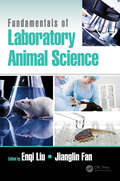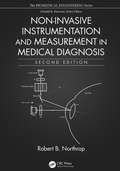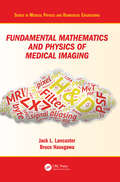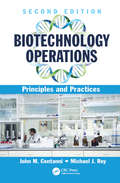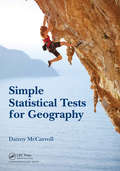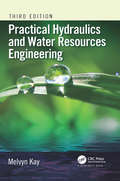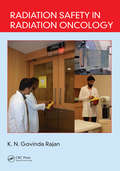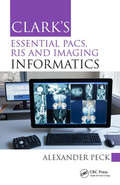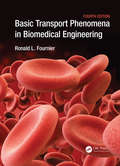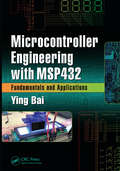- Table View
- List View
New 13+ Science Study Book for the Common Entrance Exams (PDF)
by Cgp BooksThis brilliant CGP Study Book is perfect for students preparing for the Common Entrance 13+ Science exams in 2017 and beyond - it’s suitable for Level 1, Level 2 and CASE. Every topic is clearly explained with in-depth notes, full-colour diagrams and summary questions at the end of every section to test students’ knowledge and understanding. We’ve also included a section dedicated to ‘Working Scientifically’. For even more practice, don’t miss our matching 13+ Science Practice Book (9781782948247).
Cosmology (Series in Astronomy and Astrophysics)
by Nicola VittorioModern cosmology has changed significantly over the years, from the discovery to the precision measurement era. The data now available provide a wealth of information, mostly consistent with a model where dark matter and dark energy are in a rough proportion of 3:7. The time is right for a fresh new textbook which captures the state-of-the art in cosmology. Written by one of the world's leading cosmologists, this brand new, thoroughly class-tested textbook provides graduate and undergraduate students with coverage of the very latest developments and experimental results in the field. Prof. Nicola Vittorio shows what is meant by precision cosmology, from both theoretical and observational perspectives. This book is divided into three main parts: Part I provides a pedagogical, but rigorous, general relativity-based discussion of cosmological models, showing the evidence for dark energy, the constraints from primordial nucleosynthesis and the need for inflation Part II introduces density fluctuations and their statistical description, discussing different theoretical scenarios, such as CDM, as well as observations Part III introduces the general relativity approach to structure formation and discusses the physics behind the CMB temperature and polarization pattern of the microwave sky Carefully adapted from the course taught by Prof. Vittorio at the University of Rome Tor Vergata, this book will be an ideal companion for advanced students undertaking a course in cosmology. Features: Incorporates the latest experimental results, at a time of rapid change in this field, with balanced coverage of both theoretical and experimental perspectives Each chapter is accompanied by problems, with detailed solutions The basics of tensor calculus and GR are given in the appendices
Renewable Energy: A First Course
by Robert Ehrlich Harold A. GellerThis revised edition is fully updated and continues to provide the best in-depth introduction to renewable energy science. It focuses mainly on renewable energy, but also addresses nonrenewable energy (fossil fuels and nuclear technology). The coverage extends from the basic physics to conservation, economic, and public policy issues, with strong emphasis on explaining how things work in practice. The authors avoid technical jargon and advanced math, but address fundamental analytical skills with wide application, including: Two brand new chapters giving an introduction to population dynamics and statistical analysis for energy studies Additional self-study problems and answers More worked examples Up-to-date coverage of areas such as hydraulic fracturing, integration of renewable energy to power grid, and cost.
Three-Phase Electrical Power
by Joseph E. FleckensteinThree-Phase Electrical Power addresses all aspects of three-phase power circuits. The book treats the transmission of electrical power from the common sources where it is generated to locations where it is consumed. At typical facilities where electrical power is used, the book covers the important topics of grounding, currents, power, demand, metering, circuit protection, motors, motor protection, power factor correction, tariffs, electrical drawings, and relays. Included in the text are the necessary methods of computing currents and power in all possible types of circuit applications as those that are balanced, unbalanced, leading, lagging, three-wire, and four-wire. Focusing on electrical gear, programs, and issues related to the generation and use of three-phase electrical power, this contemporary educational guide: Uses simple, straightforward language to explain key concepts and their underlying theory Introduces numerous examples, illustrations, and photographs to aid in comprehension Employs phasor concepts throughout the text to aid in the analysis of three-phase circuits Encourages applied learning by supplying practical problems at the end of each chapter Provides extensive references and a glossary of symbols, acronyms, and equations Three-Phase Electrical Power delivers a much-needed modern-day treatment of three-phase electrical power for electrical engineering students and practitioners alike.
Introduction to Polymer Chemistry
by Charles E. Carraher Jr.Introduction to Polymer Chemistry provides undergraduate students with a much-needed, well-rounded presentation of the principles and applications of natural, synthetic, inorganic, and organic polymers. With an emphasis on the environment and green chemistry and materials, this fourth edition continues to provide detailed coverage of natural and synthetic giant molecules, inorganic and organic polymers, elastomers, adhesives, coatings, fibers, plastics, blends, caulks, composites, and ceramics. Building on undergraduate work in foundational courses, the text fulfills the American Chemical Society Committee on Professional Training (ACS CPT) in-depth course requirement
Fundamentals of Laboratory Animal Science
by Enqi Liu Jianglin FanLaboratory animals are becoming increasingly important for biomedical research. It is said that approximately 70% of biomedical research is associated with the use of experimental animals. Laboratory animal research not only expands our knowledge of science, but also greatly improves human and animal health. The field of laboratory animal science is ever-growing and changing as new experimental techniques are developed and new animal models are created. It is essential to know not only the biological features of each laboratory animal but also how to use and care for them responsibly in order to perform high-quality experiments. Courses in beginning Laboratory Animal Science are starting to be offered in many universities throughout the world. However, a practical introductory textbook that contains state-of-the-art techniques is still lacking. Fundamentals of Laboratory Animal Science provides comprehensive information on the principles and practices of using laboratory animals for biomedical research. Each individual chapter focuses on a key sub-discipline of laboratory animal science: animal welfare and best humane care practices in the laboratory; the quality control of laboratory animals; the anatomy, physiology, and husbandry of commonly used species; the principles of creating and using animal models for studying human diseases; practical techniques used for laboratory animal experiments; experimental design; and animal experimentation management. Knowledge of this broad spectrum of concepts and skills will ensure research goes smoothly while greatly reducing animal pain and distress. Well-illustrated and thoroughly referenced, this book will serve not only as a standard textbook but also as a handy guide for veterinarians, researchers, animal care staff, administrators, and other professionals who are involved in laboratory animal science.
Advanced Flight Dynamics with Elements of Flight Control
by Nandan K. Sinha N. AnanthkrishnanAdvanced Flight Dynamics aim to integrate the subjects of aircraft performance, trim and stability/control in a seamless manner. Advanced Flight Dynamics highlights three key and unique viewpoints. Firstly, it follows the revised and corrected aerodynamic modeling presented previously in recent textbook on Elementary Flight Dynamics. Secondly, it uses bifurcation and continuation theory, especially the Extended Bifurcation Analysis (EBA) procedure devised by the authors, to blend the subjects of aircraft performance, trim and stability, and flight control into a unified whole. Thirdly, rather than select one control design tool or another, it uses the generalized Nonlinear Dynamic Inversion (NDI) methodology to illustrate the fundamental principles of flight control. Advanced Flight Dynamics covers all the standard airplane maneuvers, various types of instabilities normally encountered in flight dynamics and illustrates them with real-life airplane data and examples, thus bridging the gap between the teaching of flight dynamics/ control theory in the university and its practice in airplane design bureaus. The expected reader group for this book would ideally be senior undergraduate and graduate students, practicing aerospace/flight simulation engineers/scientists from industry as well as researchers in various organizations. Key Features: Focus on unified nonlinear approach, with nonlinear analysis tools. Provides an up-to-date, corrected, and unified presentation of aircraft trim, stability and control analysis including nonlinear phenomena and closed-loop stability analysis. Contains a computational tool and real-life example carried through the chapters. Includes complementary nonlinear dynamic inversion control approach, with relevant aircraft examples. Fills the gap in the market for a text including non-linear flight dynamics and continuation methods.
Computational Materials Science: An Introduction, Second Edition
by June Gunn LeeThis book covers the essentials of Computational Science and gives tools and techniques to solve materials science problems using molecular dynamics (MD) and first-principles methods. The new edition expands upon the density functional theory (DFT) and how the original DFT has advanced to a more accurate level by GGA+U and hybrid-functional methods. It offers 14 new worked examples in the LAMMPS, Quantum Espresso, VASP and MedeA-VASP programs, including computation of stress-strain behavior of Si-CNT composite, mean-squared displacement (MSD) of ZrO2-Y2O3, band structure and phonon spectra of silicon, and Mo-S battery system. It discusses methods once considered too expensive but that are now cost-effective. New examples also include various post-processed results using VESTA, VMD, VTST, and MedeA.
Non-Invasive Instrumentation and Measurement in Medical Diagnosis (Biomedical Engineering)
by Robert B. NorthropNon-Invasive Instrumentation and Measurement in Medical Diagnosis, Second Edition discusses NIMD as a rapidly growing, interdisciplinary field. The contents within this second edition text is derived from Professor Robert B. Northrop’s experience teaching for over 35 years in the Biomedical Engineering Department at the University of Connecticut. The text focusses on the instruments and procedures which are used for non-invasive medical diagnosis and therapy, highlighting why NIMD is the preferred procedure, whenever possible, to avoid the risks and expenses associated with surgically opening the body surface. This second edition also covers a wide spectrum of NIMD topics including: x-ray bone densitometry by the DEXA method; tissue fluorescence spectroscopy; optical interferometric measurement of nanometer tissue displacements; laser Doppler velocimetry; pulse oximetry; and applications of Raman spectroscopy in detecting cancer, to name a few. This book is intended for use in an introductory classroom course on Non-Invasive Medical Instrumentation and Measurements taken by juniors, seniors, and graduate students in Biomedical Engineering. It will also serve as a reference book for medical students and other health professionals intrigued by the topic. Practicing physicians, nurses, physicists, and biophysicists interested in learning state of the art techniques in this critical field will also find this text valuable. Non-Invasive Instrumentation and Measurement in Medical Diagnosis, Second Edition concludes with an expansive index, bibliography, as well as a comprehensive glossary for future reference and reading.
Introduction to Environmental Toxicology: Molecular Substructures to Ecological Landscapes, Fifth Edition
by Wayne Landis Ruth Sofield Ming-Ho YuThe fifth edition includes new sections on the use of adverse outcome pathways, how climate change changes how we think about toxicology, and a new chapter on contaminants of emerging concern. Additional information is provided on the derivation of exposure-response curves to describe toxicity and they are compared to the use of hypothesis testing. The text is unified around the theme of describing the entire cause-effect pathway from the importance of chemical structure in determining exposure and interaction with receptors to the use of complex systems and hierarchical patch dynamic theory to describe effects to landscapes.
Introduction to Nuclear Reactor Physics (500 Tips)
by Robert E. MastersonINTRODUCTION TO NUCLEAR REACTOR PHYSICS is the most comprehensive, modern and readable textbook for this course/module. It explains reactors, fuel cycles, radioisotopes, radioactive materials, design, and operation. Chain reaction and fission reactor concepts are presented, plus advanced coverage including neutron diffusion theory. The diffusion equation, Fisk’s Law, and steady state/time-dependent reactor behavior. Numerical and analytical solutions are also covered. The text has full color illustrations throughout, and a wide range of student learning features.
Fundamental Mathematics and Physics of Medical Imaging (Series in Medical Physics and Biomedical Engineering)
by Jack Lancaster Bruce HasegawaAuthored by a leading educator, this book teaches the fundamental mathematics and physics concepts associated with medical imaging systems. Going beyond mere description of imaging modalities, this book delves into the mechanisms of image formation and image quality common to all imaging systems: contrast mechanisms, noise, and spatial and temporal resolution, making it an important reference for medical physicists and biomedical engineering students. This is an extensively revised new edition of The Physics of Medical X-Ray Imaging by Bruce Hasegawa (Medical Physics Publishing, 1991), and includes a wide range of modalities such as X-ray CT, MRI and SPECT.
An Introduction to Graphene and Carbon Nanotubes
by John E. Proctor Daniel Melendrez Armada Aravind VijayaraghavanCarbon nanotubes and graphene have been the subject of intense scientific research since their relatively recent discoveries. This book introduces the reader to the science behind these rapidly developing fields, and covers both the fundamentals and latest advances. Uniquely, this book covers the topics in a pedagogical manner suitable for undergraduate students. The book also uses the simple systems of nanotubes and graphene as models to teach concepts such as molecular orbital theory, tight binding theory and the Laue treatment of diffraction. Suitable for undergraduate students with a working knowledge of basic quantum mechanics, and for postgraduate researchers commencing their studies into the field, this book will equip the reader to critically evaluate the physical properties and potential for applications of graphene and carbon nanotubes.
Cosmology for Physicists (Series in Astronomy and Astrophysics)
by David LythWritten by an award-winning cosmologist, this brand new textbook provides advanced undergraduate and graduate students with coverage of the very latest developments in the observational science of cosmology. The book is separated into three parts; part I covers particle physics and general relativity, part II explores an account of the known history of the universe, and part III studies inflation. Full treatment of the origin of structure, scalar fields, the cosmic microwave background and the early universe are provided. Problems are included in the book with solutions provided in a separate solutions manual. More advanced extension material is offered in the Appendix, ensuring the book is fully accessible to students with a wide variety of background experience.
Biotechnology Operations: Principles and Practices, Second Edition
by John M. Centanni Michael J. RoyThis book describes seven areas in the field of biotechnology operations as practiced by biopharmaceutical firms and nonprofit institutions. Revisions focus upon changes that have occurred in several areas over the past six years, with emphasis on regulatory, biomanufacturing, clinical and technical information, along with processes and guidlines that have added to the discipline. Examples are increased for new technical fields such as cell and tissue engineering. Further, illustrations or figures are added to each chapter to emphasize particular points.
Simple Statistical Tests for Geography
by Danny McCarrollThis book is aimed directly at students of geography, particularly those who lack confidence in manipulating numbers. The aim is not to teach the mathematics behind statistical tests, but to focus on the logic, so that students can choose the most appropriate tests, apply them in the most convenient way and make sense of the results. Introductory chapters explain how to use statistical methods and then the tests are arranged according to the type of data that they require. Diagrams are used to guide students toward the most appropriate tests. The focus is on nonparametric methods that make very few assumptions and are appropriate for the kinds of data that many students will collect. Parametric methods, including Student’s t-tests, correlation and regression are also covered. Although aimed directly at geography students at senior undergraduate and graduate level, this book provides an accessible introduction to a wide range of statistical methods and will be of value to students and researchers in allied disciplines including Earth and environmental science, and the social sciences.
Practical Hydraulics and Water Resources Engineering
by Melvyn KayWater is now at the centre of world attention as never before and more professionals from all walks of life are engaging in careers linked to water – in public water supply and waste treatment, agriculture, irrigation, energy, environment, amenity management, and sustainable development. This book offers an appropriate depth of understanding of basic hydraulics and water resources engineering for those who work with civil engineers and others in the complex world of water resources development, management, and water security. It is simple, practical, and avoids (most of) the maths in traditional textbooks. Lots of excellent ‘stories’ help readers to quickly grasp important water principles and practices. This third edition is broader in scope and includes new chapters on water resources engineering and water security. Civil engineers may also find it a useful introduction to complement the more rigorous hydraulics textbooks.
Radiation Safety in Radiation Oncology
by K. N. Govinda RajanThe proposed book aims to explain the basic principles, concepts and regulations behind radiation protection and their application in the field of radiation oncology practice. This book will be useful to all those students, teachers and practicing professionals involved in the field of radiation oncology.
The Standard Model and Beyond (Series in Particle Physics, Cosmology and Gravitation)
by Paul LangackerThis new edition of The Standard Model and Beyond presents an advanced introduction to the physics and formalism of the standard model and other non-abelian gauge theories. It provides a solid background for understanding supersymmetry, string theory, extra dimensions, dynamical symmetry breaking, and cosmology. In addition to updating all of the experimental and phenomenological results from the first edition, it contains a new chapter on collider physics; expanded discussions of Higgs, neutrino, and dark matter physics; and many new problems. The book first reviews calculational techniques in field theory and the status of quantum electrodynamics. It then focuses on global and local symmetries and the construction of non-abelian gauge theories. The structure and tests of quantum chromodynamics, collider physics, the electroweak interactions and theory, and the physics of neutrino mass and mixing are thoroughly explored. The final chapter discusses the motivations for extending the standard model and examines supersymmetry, extended gauge groups, and grand unification. Thoroughly covering gauge field theories, symmetries, and topics beyond the standard model, this text equips readers with the tools to understand the structure and phenomenological consequences of the standard model, to construct extensions, and to perform calculations at tree level. It establishes the necessary background for readers to carry out more advanced research in particle physics. Supplementary materials are provided on the author’s website and a solutions manual is available for qualifying instructors.
Clark's Essential PACS, RIS and Imaging Informatics (Clark's Companion Essential Guides)
by Alexander PeckImaging informatics is a complex and historically rapidly changing field, knowledge of which is central to the practice of all imaging specialists. This convenient pocket guide provides the foundations of knowledge in informatics, allowing radiographers in training and in practice, assistant practitioners and other allied health professionals to understand, use and develop more efficient ways of imaging that will in turn deliver improved patient care.
Basic Transport Phenomena in Biomedical Engineering
by Ronald L. FournierThis will be a substantial revision of a good selling text for upper division/first graduate courses in biomedical transport phenomena, offered in many departments of biomedical and chemical engineering. Each chapter will be updated accordingly, with new problems and examples incorporated where appropriate. A particular emphasis will be on new information related to tissue engineering and organ regeneration. A key new feature will be the inclusion of complete solutions within the body of the text, rather than in a separate solutions manual. Also, Matlab will be incorporated for the first time with this Fourth Edition.
Fundamentals of Optomechanics (Optical Sciences and Applications of Light)
by Daniel Vukobratovich Paul YoderThis textbook will provide the fundamentals of optomechanics. Starting from the basics, this textbook will lead you through the opto-mechanical design process, discussing materials selection, principles of kinematic design, as well as mounting of windows, individual lenses, and multiple lenses. Techniques for mounting prisms, mirror performance, and design and mounting of mirrors will be included. Written by the two top scientists in the field, this stand-alone, student-friendly textbook has been course-tested and will include homework problems as well as a solutions manual for adopting professors.
Introduction to Rocket Science and Engineering
by Travis S. TaylorIntroduction to Rocket Science and Engineering, Second Edition, presents the history and basics of rocket science, and examines design, experimentation, testing, and applications. Exploring how rockets work, the book covers the concepts of thrust, momentum, impulse, and the rocket equation, along with the rocket engine, its components, and the physics involved in the generation of the propulsive force. The text also presents several different types of rocket engines and discusses the testing of rocket components, subsystems, systems, and complete products. The final chapter stresses the importance for rocket scientists and engineers to creatively deal with the complexities of rocketry.
Photovoltaic Systems Engineering
by Roger A. Messenger Amir AbtahiThe primary purpose of PV Systems Engineering is to provide a comprehensive set of PV knowledge and understanding tools for the design, installation, commissioning, inspection, and operation of PV systems. During recent years in the United States, more PV capacity was installed than any other electrical generation source. In addition to practical system information, this new edition includes explanation of the basic physical principles upon which the technology is based and a consideration of the environmental and economic impact of the technology. The material covers all phases of PV systems from basic sunlight parameters to system commissioning and simulation, as well as economic and environmental impact of PV. With homework problems included in each chapter and numerous design examples of real systems, the book provides the reader with consistent opportunities to apply the information to real-world scenarios.
Microcontroller Engineering with MSP432: Fundamentals and Applications
by Ying BaiThis book aims to develop professional and practical microcontroller applications in the ARM-MDK environment with Texas Instruments MSP432P401R LaunchPad kits. It introduces ARM Cortex-M4 MCU by highlighting the most important elements, including: registers, pipelines, memory, and I/O ports. With the updated MSP432P401R Evaluation Board (EVB), MSP-EXP432P401R, this MCU provides various control functions with multiple peripherals to enable users to develop and build various modern control projects with rich control strategies. Micro-controller programming is approached with basic and straightforward programming codes to reduce learning curves, and furthermore to enable students to build embedded applications in more efficient and interesting ways. For authentic examples, 37 Class programming projects are built into the book that use MSP432P401R MCU. Additionally, approximately 40 Lab programming projects with MSP432P401R MCU are included to be assigned as homework.





